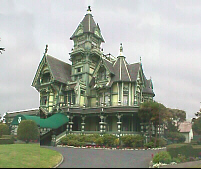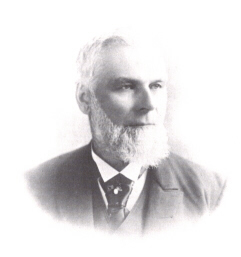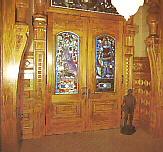 Riding down the famed Highway 101 from Oregon, just over the border into California, we passed
through the picturesque town of Eureka. We actually had no particular plans for stopping as
we were on our way to the "Avenue of Giants" drive further south. As we passed through the
heart of town, a steeple on a building several blocks off the main road caught Laura's eye.
As she is a bit of an impulsive driver she simply made a right turn and wondered off onto
the side streets on yet another impromptu adventure. What she had seen was the Carson mansion,
a three story Victorian house of 18 rooms, located at Second and M streets .
Now known as the Ingomar Club, it was built between 1884-86 and was occupied by the family
until purchased in 1950 by a group of Eureka businessmen to preserve the structure's
unique 19th century splendor.
Riding down the famed Highway 101 from Oregon, just over the border into California, we passed
through the picturesque town of Eureka. We actually had no particular plans for stopping as
we were on our way to the "Avenue of Giants" drive further south. As we passed through the
heart of town, a steeple on a building several blocks off the main road caught Laura's eye.
As she is a bit of an impulsive driver she simply made a right turn and wondered off onto
the side streets on yet another impromptu adventure. What she had seen was the Carson mansion,
a three story Victorian house of 18 rooms, located at Second and M streets .
Now known as the Ingomar Club, it was built between 1884-86 and was occupied by the family
until purchased in 1950 by a group of Eureka businessmen to preserve the structure's
unique 19th century splendor.
Eureka lies in the heart of the Redwood Empire, renowned for the magnificent coastal redwoods
"Sequoia sempervirens". In 1850, gold was found in the nearby Trinity region, and prospectors
needed a more convenient alternate to the tedious overland route from Sacramento.
Schooners and other vessels soon arrived in Humboldt Bay, supplying the men working on the
Trinity and Klamath Rivers. As in all gold rush areas most prospectors soon ran out of
supplies and the money to buy more. Many had come from the nearby timber lands and returned
to their trade, harvesting the trees that abounded all around. The next four years saw
seven saw mills open in Eureka. In another year there were 140 schooners in Humboldt Bay
ferrying lumber to the growing cities up and down the Pacific coast.
for the magnificent coastal redwoods
"Sequoia sempervirens". In 1850, gold was found in the nearby Trinity region, and prospectors
needed a more convenient alternate to the tedious overland route from Sacramento.
Schooners and other vessels soon arrived in Humboldt Bay, supplying the men working on the
Trinity and Klamath Rivers. As in all gold rush areas most prospectors soon ran out of
supplies and the money to buy more. Many had come from the nearby timber lands and returned
to their trade, harvesting the trees that abounded all around. The next four years saw
seven saw mills open in Eureka. In another year there were 140 schooners in Humboldt Bay
ferrying lumber to the growing cities up and down the Pacific coast.
 Arriving with some of the first prospectors was a Canadian timberman named William Carson. Just 24, he
and his friends were determined to strike it rich in the great California Gold fields. When this failed to turn
out, young Carson and his friends turned to lumbering the giant trees for the, just opened, first sash mill
in Eureka. It is believed that William Carson with the help of Jerry Whitmore chopped down the first
saw-log in Humboldt County.
Arriving with some of the first prospectors was a Canadian timberman named William Carson. Just 24, he
and his friends were determined to strike it rich in the great California Gold fields. When this failed to turn
out, young Carson and his friends turned to lumbering the giant trees for the, just opened, first sash mill
in Eureka. It is believed that William Carson with the help of Jerry Whitmore chopped down the first
saw-log in Humboldt County.
Remaining a bachelor for 38 years, William Carson finally married Sarah Wilson in 1864. They would have
3 boys and a girl which they would raise in a modest two-story house. It was not until the children were
older that Carson found time to consider a new house. This mansion would be the showplace for Eureka,
from the day it was finished to the present day. It has been touted as the “most photographed residence in America”,
though I question that, considering 1600 Pennsylvania Ave. One can certainly find
its image in drawings,
painting and film throughout the US.
 A broad porch rims the front and south side of the house. Wide steps provide the two major
entrances. Huge carved pillars stand on balustrades. Rhododendrons abound in the garden
area below. The carved front main entrance is representative of William Carson's love of wood.
Honey colored primavera hardwood from South America frames the doorway in the entry hall.
Large panels of colored leaded glass have figures from Shakespearean dramas.
A broad porch rims the front and south side of the house. Wide steps provide the two major
entrances. Huge carved pillars stand on balustrades. Rhododendrons abound in the garden
area below. The carved front main entrance is representative of William Carson's love of wood.
Honey colored primavera hardwood from South America frames the doorway in the entry hall.
Large panels of colored leaded glass have figures from Shakespearean dramas.
Carson would try prospecting one more time before returning to Eureka with
his friends who would soon go their separate ways. By 1854, Carson was an established figure in the
community, having taken over the operations of the Muley Mill, which processed Spruce and Cedar only, as no
one cared to tackle the 400 ton Redwoods even though they knew it was where the big money lay.
 The huge hallways on the second floor shows and Oriental influence, particularly in its arches
and niches. What appears to be wood carving in the arches are actually fine impressions of
plaster molding. Some of the molds are still in the basement. Redwood pillars at the right
sit on a handy primavera railing, which shows the rich color contrast between the wood.
The huge hallways on the second floor shows and Oriental influence, particularly in its arches
and niches. What appears to be wood carving in the arches are actually fine impressions of
plaster molding. Some of the molds are still in the basement. Redwood pillars at the right
sit on a handy primavera railing, which shows the rich color contrast between the wood.
